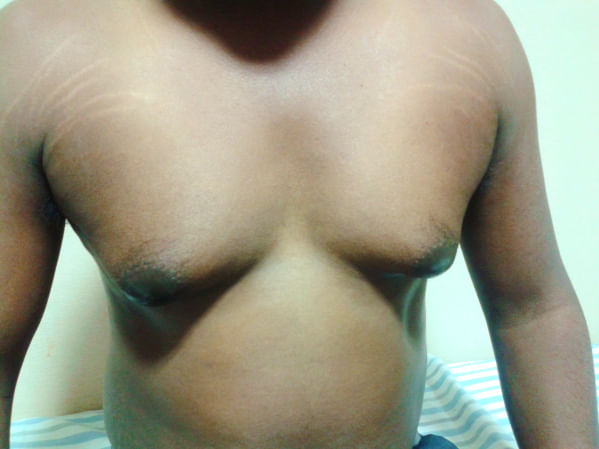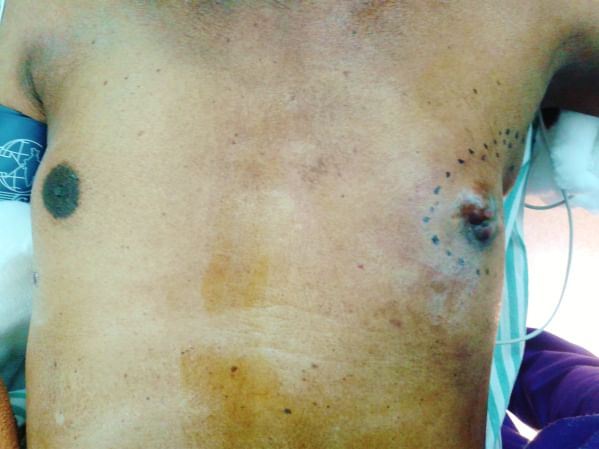Get the App
For Doctors
Login/Sign-up
Last Updated: Aug 29, 2019
BookMark
Report
Male Breast Cancer - it does happen!!
Dr. Rohan KhandelwalOncologist • 17 Years Exp.MBBS, MS - General Surgery, MRCS (Edinburgh), Fellowship In Breast Surgery, Fellowship In Onco-plastic Breast Surgery
Although breast cancer is predominantly a female disease, males are not immune to this cancer. Male breast cancer comprises 1% of all breast cancer diagnosis.
Risk factors for Male Breast Cancer:
1. Age: The risk increases with increasing age and male breast cancer usually presents in the 6th or the 7th decade of life
2. Family history of breast cancer/ Inherited gene mutations: The chances of male breast cancer are higher in people with BRCA 2 mutation and a positive family history of breast cancer
Alcohol
3. Klinefelter’s syndrome: Men with Klinefelter syndrome have small testicles (smaller than usual). Often, they are unable to produce functioning sperm cells, making them infertile. Compared with other men, they have lower levels of androgens (male hormones) and more estrogens (female hormones). For this reason, they often develop gynecomastia (benign enlargement of the male breast), which is also a differential diagnosis of male breast cancer.Patients with this syndrome have a higher incidence of Male Breast Cancer.
4. Radiation exposure
5. Exposure to estrogen: Excessive exposure to estrogen increases the chances of male breast cancer.
6. Liver disease
7. Obestiy
8. Testicular problems: Undescended testis, mumps and Klinefelter’s syndrome increases the chances of male breast cancer.
A common differential diagnosis of Male Breast Cancer is Gynecomastia (benign enlargement of the male breast). Gynecomastia usually results from an imbalance between androgen and estrogen production. This is commonly seen in adolescents or in elderly patients because testosterone levels increase during puberty and decrease with age. Besides these causes, many drugs—including steroids, antidepressants, diuretics, and antihypertensive medications—have also been implicated in the development of gynecomastia, although as many as 50% of cases have no known identifiable cause.
Certain risk factors are common to both gynecomastia and carcinoma: breast irradiation, mumps orchitis, and bilateral cryptorchidism (undescended testis), Klinefelter’s syndrome.
Symptoms:
Lack of awareness is the major cause which prevents early diagnosis of this condition in males. Following are the danger signs, which can point towards a male breast cancer:
If you notice any persistent changes to your breasts, you should contact your doctor. Here are some signs to watch for:
a lump in the breast
nipple pain
an inverted nipple
nipple discharge (clear or bloody)
enlarged lymph nodes under the arm
Diagnosis:
Diagnosis of male breast cancer is achieved on the same lines as female breast cancer. Patient is usually subjected to an imaging test followed by histo-pathological confirmation of the diagnosis.
Some patients also require extensive work-up to rule out metastasis to other parts of the body.
Management & Prognosis:
Management of male breast cancer is similar to female breast cancer.
By virtue of the proximity between most male breast cancers and the skin and chest wall, extension to or invasion of these structures is more commonly observed than in women but the prognosis of male breast cancer remains the same as female breast cancer.
Risk factors for Male Breast Cancer:
1. Age: The risk increases with increasing age and male breast cancer usually presents in the 6th or the 7th decade of life
2. Family history of breast cancer/ Inherited gene mutations: The chances of male breast cancer are higher in people with BRCA 2 mutation and a positive family history of breast cancer
Alcohol
3. Klinefelter’s syndrome: Men with Klinefelter syndrome have small testicles (smaller than usual). Often, they are unable to produce functioning sperm cells, making them infertile. Compared with other men, they have lower levels of androgens (male hormones) and more estrogens (female hormones). For this reason, they often develop gynecomastia (benign enlargement of the male breast), which is also a differential diagnosis of male breast cancer.Patients with this syndrome have a higher incidence of Male Breast Cancer.
4. Radiation exposure
5. Exposure to estrogen: Excessive exposure to estrogen increases the chances of male breast cancer.
6. Liver disease
7. Obestiy
8. Testicular problems: Undescended testis, mumps and Klinefelter’s syndrome increases the chances of male breast cancer.
A common differential diagnosis of Male Breast Cancer is Gynecomastia (benign enlargement of the male breast). Gynecomastia usually results from an imbalance between androgen and estrogen production. This is commonly seen in adolescents or in elderly patients because testosterone levels increase during puberty and decrease with age. Besides these causes, many drugs—including steroids, antidepressants, diuretics, and antihypertensive medications—have also been implicated in the development of gynecomastia, although as many as 50% of cases have no known identifiable cause.
Certain risk factors are common to both gynecomastia and carcinoma: breast irradiation, mumps orchitis, and bilateral cryptorchidism (undescended testis), Klinefelter’s syndrome.
Symptoms:
Lack of awareness is the major cause which prevents early diagnosis of this condition in males. Following are the danger signs, which can point towards a male breast cancer:
If you notice any persistent changes to your breasts, you should contact your doctor. Here are some signs to watch for:
a lump in the breast
nipple pain
an inverted nipple
nipple discharge (clear or bloody)
enlarged lymph nodes under the arm
Diagnosis:
Diagnosis of male breast cancer is achieved on the same lines as female breast cancer. Patient is usually subjected to an imaging test followed by histo-pathological confirmation of the diagnosis.
Some patients also require extensive work-up to rule out metastasis to other parts of the body.
Management & Prognosis:
Management of male breast cancer is similar to female breast cancer.
By virtue of the proximity between most male breast cancers and the skin and chest wall, extension to or invasion of these structures is more commonly observed than in women but the prognosis of male breast cancer remains the same as female breast cancer.




+1.svg)
